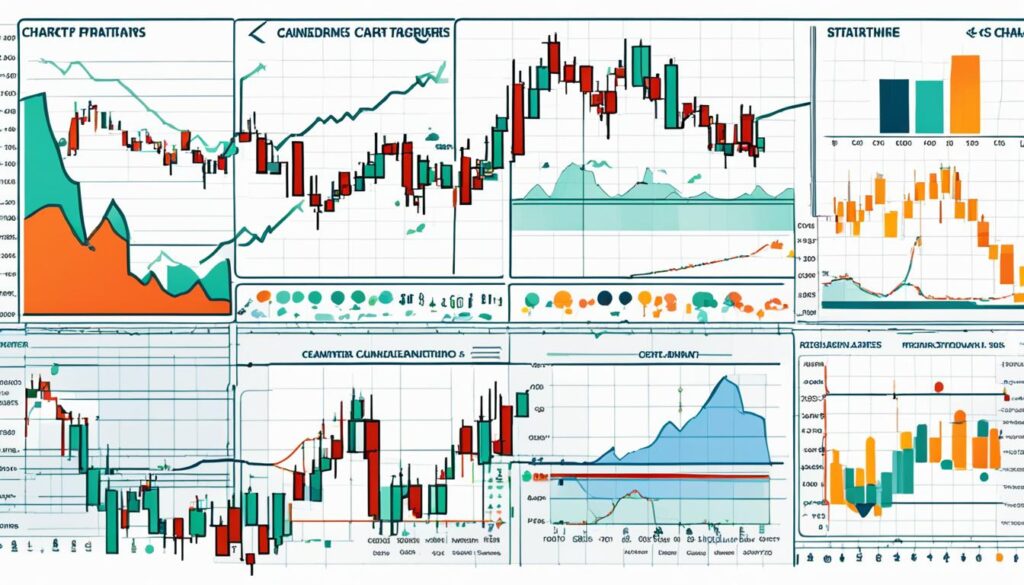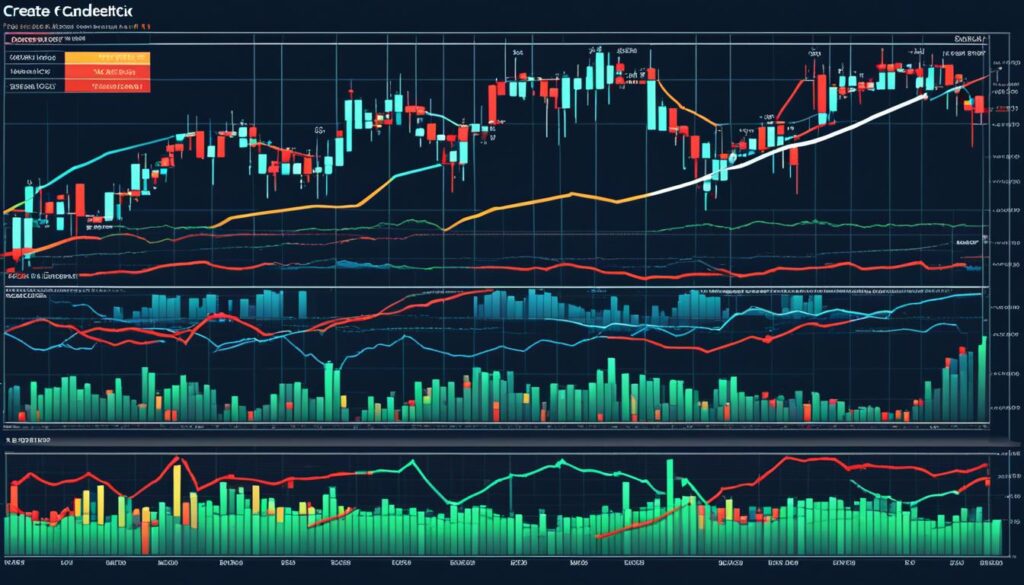Reading Forex Charts for Beginners: A Simple Guide
Every day, about $6.6 trillion in foreign currencies change hands worldwide. This makes the Forex market one of the largest and most fast-moving financial markets. For beginners, diving into this vast sea of opportunity demands a strong guide to reading Forex charts.
Reading and understanding Forex charts goes beyond just looking at lines and bars. They act as detailed maps showing market feelings and trading behavior. By studying these charts, you can make better decisions, which can lead to more gainful trades.
Services like TPT Forex and TPT CopyTrading are really helpful for newcomers. They offer the necessary tools and insights to turn complex data into practical strategies. With these aids, you can build the essential skills for successful trading, setting off your Forex journey in the right direction.
Key Takeaways
- The Forex market trades around $6.6 trillion per day.
- Understanding Forex charts is crucial for making informed trading decisions.
- Charts reflect market sentiments and trading psychology.
- TPT Forex and TPT CopyTrading can assist beginners in analyzing charts.
- A proper guide to reading Forex charts can lead to profitable trades.
Introduction to Forex Trading
Learning about Forex trading can lead to many financial opportunities. It is the trading of world currencies. It is the largest and most liquid market globally. You buy one currency and sell another at the same time.
What is Forex Trading?
Forex trading is about exchanging global currencies. People and big groups trade to make money from currency price changes. Things like big events, economic news, and how people feel about the market can change currency prices. Getting good at Forex basics lets you handle the quick changes in the market.
Why Learn to Read Forex Charts?
Learning to read Forex charts is a key step in trading. These charts show market data in pictures. They help you see patterns, find opportunities, and understand risks. Knowing how to read them makes your trading smarter. With TPT Forex and TPT CopyTrading, you can learn from successful traders and get better at trading.
Understanding Currency Pair Charts
In Forex trading, knowing how to read currency pair charts is key. It helps spot market chances and choose wisely. Currency pairs show how much one currency is worth against another. Traders use this info to figure out each currency’s strength and weaknesses.

Base and Quote Currency
On currency pair charts, the first currency is the base currency. The second is the quote currency. For example, in EUR/USD, EUR is the base currency and USD is the quote currency. This tells us the value of 1 euro in dollars. Seeing this fact clearly is crucial for market predictions.
Major vs Minor Currency Pairs
Forex focuses on major and minor pairs. Major pairs, like EUR/USD and GBP/USD, involve the most traded currencies. They offer good stability and narrow spreads. On the other hand, minor pairs like EUR/CZK and GBP/SGD are from smaller economies. They’re more volatile, with wider spreads. Knowing this distinction helps in trading.
| Major Pairs | Minor Pairs |
|---|---|
| EUR/USD | EUR/CZK |
| GBP/USD | GBP/SGD |
| USD/JPY | AUD/NZD |
Tools like TPT Forex and TPT CopyTrading are great for major and minor pair analysis. They keep you informed, which is vital for trading success.
Types of Forex Charts
Learning about Forex charts is key for those on platforms like TPT Forex and TPT CopyTrading. Each chart type gives special insights that help with trading plans. We’ll look into Line, Bar, and Candlestick charts.
Line Charts
Line charts show closing prices over time, making trends clear. They’re great for beginners to spot market direction quickly.
Bar Charts
Bar charts deliver more details by showing opening, high, low, and closing prices in each period. With each bar, traders can observe price movements within the period. This detail is useful for spotting volatility and patterns, shedding light on trading dynamics.
Candlestick Charts
Candlestick charts are popular for their look and detailed data. Each one shows a time period and its open, high, low, and close. They’re colored to show price increase (green) or decrease (red), aiding quick sentiment analysis.
| Chart Type | Features | Best For |
|---|---|---|
| Line Charts | Closing prices, Simple trend view | Quick snapshot of trends |
| Bar Charts | Open, High, Low, Close prices | Market volatility insights |
| Candlestick Charts | Open, High, Low, Close prices, Color-coded | Detailed market sentiment |
Getting to know these chart types helps in reading patterns effectively. Test each on TPT Forex to find what suits your strategy best.
Basic Elements of Forex Charts
Learning about Forex charts is key for new traders. They include time frames, the price axis, and volume indicators. These elements show what the market is doing and help traders plan their moves better.

Time Frames
Time frames look at market data over different time periods. You might check on an hourly basis, or only daily and weekly. This knowledge helps traders of all kinds pick the right strategies to reach their goals. Try platforms like TPT CopyTrading to see how different strategies work.
“Time frames allow you to see both the forest and the trees. It’s about understanding the bigger picture while also focusing on detailed, short-term movements.” — TPT Forex
Price Axis
The price axis tells you the exchange rate of currency pairs. It runs up the right side of the chart. Understanding this part helps traders spot trends and choose better times to buy or sell. With this skill, you can make wiser trading choices.
Volume Indicators
Volume indicators are very important on Forex charts. They track how much trading happens in a certain time. Big trading volumes often show the market is strong, while small volumes might mean it’s about to shift. Using these indicators can improve how well you predict the market and do trades that earn money.
| Component | Description |
|---|---|
| Time Frames | Analyzing data over different periods for varied trading strategies. |
| Price Axis | Displays the value of currency pairs, aiding in trend analysis. |
| Volume Indicators | Measure trading volumes to confirm trends or signal potential reversals. |
How to Read Forex Charts for Beginners
How to read Forex charts for beginners is key to starting online trading right. You’ll learn to understand price shifts, see patterns, and do simple trend checks.
First off, note the key parts of the charts. You should look at price movement, time frames, and trade volume. These let you look at Forex charts well and decide on trades smartly.
Step-by-Step Guidance
- Identify Price Movements: Charts will show if prices are going up or down. Pay attention to these changes over different times.
- Recognize Patterns: Watch for shapes like head and shoulders, or double tops and bottoms. These can hint at what prices might do next.
- Analyze Trends: Drawing lines on the chart can show where the market is headed. Knowing if it’s going up, down, or staying flat is important for making choices.
For hands-on help, check out TPT Forex and TPT CopyTrading. They have tools that make Forex chart readings easier and more effective.
| Chart Component | Function |
|---|---|
| Price Axis | Shows the price levels of the currency pairs. |
| Time Frames | Displays the duration for which the price movements are shown. |
| Volume Indicators | Indicates the volume of trading for a specific time frame. |
Introduction to Technical Analysis Indicators
To do well in Forex trading, understanding technical analysis indicators is key. They let traders look at market trends, find trading chances, and make smart choices.
Moving Averages
Moving averages are very popular in the world of Forex trading. They smooth out price data to show trends over time. The two main types are:
- Simple Moving Averages (SMA): They find the average of closing prices over a set time.
- Exponential Moving Averages (EMA): EMA gives recent prices more importance, reacting faster to new data.
Traders use moving averages to see where trends and reversals might happen. For example, if the price goes above the average, it could mean an upward trend.
Relative Strength Index (RSI)
The RSI measures the change in price movements between 0 and 100. This helps spot times when a currency might be overbought or oversold:
- RSI above 70 means it might be overbought.
- RSI below 30 means it might be oversold.
In Forex, RSI can show when trends might change. Using RSI with moving averages can make your strategy stronger.

Platforms like TPT Forex and TPT CopyTrading help you use these indicators in your trading. This makes it easier to make decisions based on data.
Candlestick Patterns in Forex Charts
Understanding Candlestick patterns Forex is key for traders who want to make smart moves. They show you what might happen with prices next. This makes them very important for trading on websites like TPT Forex and TPT CopyTrading.
Common Candlestick Patterns
Knowing common Forex chart patterns can really help your trading game. Here are a few you might see a lot:
- Doji: It shows the market isn’t sure which way to go, hinting at a possible change.
- Hammer: This bullish pattern suggests a turning point from a downtrend to an upswing.
- Engulfing Patterns: They can mean either a big upturn or downturn is coming.
Interpreting Candlestick Signals
Decoding candlestick charts includes looking at when and where a pattern shows up. For example, a bullish engulfing pattern after prices have been falling could mean it’s time to buy. Here’s how to analyze these signals:
- Always check if the pattern agrees with other signs.
- Watch the trading volume; more trading typically backs a stronger signal.
- Think about how people feel about the market and any big news that could change prices.
Trend Identification Methods
Learning to spot trends is crucial for successful Forex trading. Here, we’ll look at methods like moving averages for trends and drawing trendlines. These tools guide us in making smart trading choices. Understanding trends in Forex is vital for strategy success.
Moving Averages for Trend Detection
To start identifying trends in Forex, many use moving averages. This technique smooths out price data. It shows the market’s general direction vividly. By averaging prices over time, moving averages show support and resistance zones. You can choose between Simple Moving Average (SMA) and Exponential Moving Average (EMA) based on your needs.
Trendlines
Drawing trendlines is also key in recognizing trends. You connect highs or lows to see the current trend. Trendlines confirm a trend’s strength and direction. They give you clear information for your trading moves. A trendline touching many points is more powerful in identifying trends in Forex.
| Method | Description | Usage in Forex |
|---|---|---|
| Moving Averages | Calculates average price over a period | Used for smoothing price data |
| Trendlines | Draws lines connecting highs or lows | Visualizes market trends |
Support and Resistance Levels
Finding support and resistance levels is key for good Forex trading. These points show where a price might change direction. They let traders know when to buy or sell, boosting their success.
Support and resistance levels are like invisible walls for prices. A support level is where prices stop falling. A resistance level is where they stop rising. Knowing about these levels is important for doing well in Forex trading.
The TPT Forex platform makes it easier to find and use these levels. You can improve your trading by using features like TPT CopyTrading.
Here’s a quick look at support and resistance levels:
| Aspect | Support Levels | Resistance Levels |
|---|---|---|
| Definition | A price point where a downtrend can pause due to demand concentration | A price point where an uptrend can pause due to selling pressure |
| Indicator | Price bounces up from this level | Price bounces down from this level |
| Trader Strategy | Buy signal | Sell signal |
| Trading Tools | Trendlines, Moving Averages | Trendlines, Moving Averages |
Spotting these levels right lets you make better trades and control risks. With the TPT platform or on your own, knowing about support and resistance levels helps in the Forex market.
Price Action Trading Strategies
Price action strategies help Forex traders by looking at price history. We will discuss three common methods: the pin bar, inside bar, and trend following. Learning these can improve your trading decisions and help match market trends. Let’s get into how each strategy works and how you can use them.

Pin Bar Strategy
The pin bar is key in price action trading. It shows a possible change in market direction with its small body and long tail. Traders use this to find entry points and guess market turns. Understanding pin bars can boost your trading when markets switch.
Inside Bar Strategy
The inside bar strategy is also essential in price action. It happens when a small candle forms inside a larger one. This hints at a market breakout, letting traders get ready for big price changes. Learning to trade inside bars helps capture big profits.
Trend Following Strategy
Trend following is crucial for success in Forex. It means going with the main market trend. This strategy lowers risks and raises your chances of success. Using tools like moving averages helps spot trends and make smart moves.
Adding these strategies to your trading can make dealing with the Forex market easier. Platforms like TPT Forex and TPT CopyTrading help put these methods to use in real markets. They can improve your trading efforts.
Effective Chart Reading Techniques
Learning how to read charts better helps you make smarter trading choices. It’s key to mix looking at multiple time frames and using technical indicators. This way, you see the bigger picture while also focusing on the details.
Multi-Time Frame Analysis
Looking at different time frames in Forex shows you the market’s ups and downs. It helps spot trends over time and sudden changes up close. So, you can reduce risks and aim for bigger profits.
Think about it like this: start with the whole-story daily chart. Then, look closer with a 4-hour chart to find the best moments to get in or out. TPT Forex has what you need for this, making trading smoother.
Combining Technical Indicators
Using many indicators together makes your trading signals stronger. It clears up market confusion and backs up your trading choices. A good mix includes pairings like moving averages with RSI or Bollinger Bands with stochastic indicators.
Let’s see how some combos work:
| Indicator Combination | Purpose |
|---|---|
| Moving Averages + RSI | Identifies trend direction and momentum strengths |
| Bollinger Bands + Stochastic Oscillators | Detects volatility and potential price reversals |
| MACD + Fibonacci Retracement | Highlights trend changes and support/resistance levels |
Use tools and places like TPT CopyTrading to manage these indicators well. Using Forex indicators the right way builds a strong strategy for trading success.
Risk Management for Beginners
For new traders, managing risks in Forex trading is key. When you use the right methods, you keep your trading going well and making a profit. We’ll look at how to use stop-loss orders and figure out how much to trade.
Setting Stop-Loss Orders
Using stop-loss orders is vital in Forex risk management. Stop-loss orders let you set a price to automatically sell if reached, limiting your losses. Top traders on TPT CopyTrading rely on them to protect their money. This way, they guard against big market swings and sudden events.
Determining Position Size
Finding the right position size is also crucial for managing risk in Forex. It’s the process of deciding how much of your money to trade with. Good position sizing prevents you from losing too much at once. Experts at TPT Forex stress how this keeps your trading safe and balanced. By adjusting your trade sizes wisely, you can control your risk based on your plan and the market.
Conclusion
Starting your Forex trading journey means becoming great at reading charts. In this guide, we’ve looked at the basics. We covered things like time frames and the price axes. We also dove into technical indicators such as Moving Averages and RSI.
Now, you should understand Forex charts pretty well. Knowing candlestick patterns, spotting trends with moving averages, and finding support and resistance levels are key. These are practical skills that help you trade smarter in the Forex market.
As you get better at reading charts, remember to keep learning. The market always changes. Tools like TPT Forex and TPT CopyTrading offer insights and chances to grow. Keep practicing, keep getting new info, and take advantage of what the Forex market has to offer. This way, you’ll harness the full power of your Forex knowledge.
